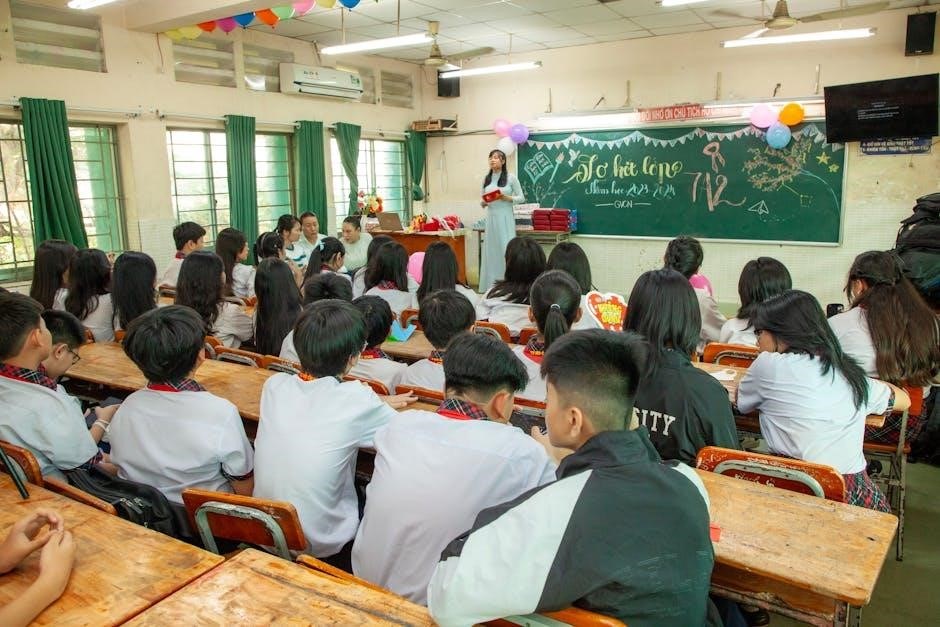Gagné’s Nine Events of Instruction provide a structured approach to designing effective learning experiences. Developed in 1965, this model outlines nine sequential steps to ensure learners engage with and retain information. It emphasizes clear objectives, active participation, and feedback, making it a cornerstone of modern instructional design. The events are widely applied in both traditional and digital learning environments to enhance educational outcomes.

Overview of Robert Gagné and His Contribution to Instructional Design
Robert Gagné was a pioneering educational psychologist whose work fundamentally shaped instructional design. His seminal book, The Conditions of Learning, introduced the Nine Events of Instruction in 1965, a framework that systematically addresses the mental conditions necessary for effective learning. Gagné’s model integrates behaviorist and cognitivist principles, emphasizing clear objectives, learner engagement, and structured feedback. His contributions transformed how educators and trainers design learning experiences, making his work a cornerstone of both traditional and digital education. Gagné’s approach remains influential, particularly in e-learning, where his principles are adapted to enhance engagement and outcomes in modern educational settings.
The Importance of the Nine Events in Modern Education
Gagné’s Nine Events of Instruction remain highly relevant in modern education due to their structured approach to learning design. By breaking down the instructional process into clear, sequential steps, educators can create engaging and effective learning experiences. The model’s emphasis on active participation, feedback, and alignment with learning objectives aligns with contemporary educational priorities, such as personalized learning and measurable outcomes. Its adaptability to digital platforms has further cemented its importance in e-learning environments, where capturing attention and ensuring knowledge retention are critical challenges. The Nine Events provide a timeless framework for educators to design instruction that supports diverse learning needs and fosters long-term knowledge application.

The Nine Events of Instruction: A Detailed Breakdown
Gagné’s Nine Events provide a systematic framework for designing instruction, ensuring engagement, clarity, and retention. Each event addresses specific conditions of learning, creating a cohesive learning experience.
Gain Attention: Strategies to Engage Learners
Gaining attention is the first step in Gagné’s model, essential for engaging learners. This can be achieved through thought-provoking questions, quotes, statistics, or relevant real-world events. Using images, short videos, or stories also helps capture interest. In digital settings, interactive elements like polls or quizzes can be effective. The goal is to distract learners from other tasks and focus their minds on the lesson. By stimulating curiosity, instructors create a receptive environment for new information. This step ensures learners are mentally prepared and motivated to participate actively in the learning process. Effective attention-grabbing strategies set the stage for a focused and productive educational experience.

Inform Learners of the Objectives: Setting Clear Goals
Informing learners of the objectives is the second event in Gagné’s model. This step involves clearly stating what learners will achieve and how they can apply the knowledge. Objectives should be specific, measurable, and aligned with the lesson’s goals. By doing so, learners understand what is expected of them, reducing confusion and focusing their efforts. This step also aligns with Bloom’s Taxonomy, which emphasizes moving from basic knowledge to higher-level thinking. Clear objectives help learners stay motivated and directed, ensuring they grasp the relevance of the material. This transparency fosters a purposeful learning environment, setting the foundation for meaningful engagement and outcomes.
Stimulate Recall of Prior Learning: Connecting New Information to Existing Knowledge

Stimulating recall of prior learning is the third event in Gagné’s model, aiming to connect new information to learners’ existing knowledge. This step helps learners retrieve relevant past experiences, creating a foundation for new concepts. Techniques such as discussions, quizzes, or reflective exercises can be used to activate prior knowledge. By bridging the gap between what learners already know and what they are about to learn, this step enhances understanding and retention. It ensures that new information builds on familiar ground, making it more meaningful and easier to integrate into long-term memory. This connection is crucial for fostering a cohesive and effective learning experience.
Present the Content: Effective Methods for Information Delivery
Presenting the content is the fourth event in Gagné’s model, focusing on clear and structured delivery of information. This step involves using various methods such as lectures, demonstrations, videos, or interactive activities to convey the material. The goal is to ensure learners can easily understand and process the information. Organizing content logically and using visual aids or examples can enhance comprehension. Additionally, matching the presentation style to the learners’ preferences and needs ensures engagement. Effective presentation methods help bridge the gap between instruction and understanding, making the content accessible and meaningful for all learners. This step is critical for ensuring that the learning objectives are met through clear and concise information delivery.
Provide Learning Guidance: Supporting Learners Through the Process
Providing learning guidance is the fifth event in Gagné’s model, focusing on supporting learners as they engage with the content. This step ensures learners understand and apply the information effectively. Strategies include scaffolding, where complex tasks are broken into manageable parts, and providing examples or demonstrations to clarify concepts. Active learning techniques, such as group discussions or hands-on activities, also fall under this event. Additionally, offering feedback and encouragement helps learners stay motivated and on track. Guidance bridges the gap between instruction and understanding, ensuring learners can connect new information to their existing knowledge and apply it in meaningful ways. This step is essential for fostering independence and confidence in learners.
Elicit Performance (Practice): Active Application of Knowledge
Eliciting performance, or practice, is the sixth event in Gagné’s model, where learners actively apply what they have learned. This step ensures that learners can demonstrate their understanding by performing tasks or solving problems. Strategies include interactive exercises, simulations, or group activities that require the application of knowledge. Feedback is provided to guide learners and refine their skills. This event bridges the gap between instruction and real-world application, reinforcing learning and preparing learners for independent performance. By engaging in practice, learners develop confidence and competence, ensuring they can transfer their knowledge to new situations effectively.
Provide Feedback: Enhancing Learning Through Constructive Responses
Providing feedback is a critical step in Gagné’s model, as it helps learners understand their performance and identify areas for improvement. Constructive feedback clarifies strengths and weaknesses, reinforcing correct behaviors and guiding learners toward mastery. Immediate and specific responses are most effective, allowing learners to adjust their understanding and skills. Feedback can be verbal, written, or through digital tools, ensuring it is timely and actionable. This step bridges the gap between performance and mastery, fostering a deeper understanding of the material. By addressing misconceptions and celebrating successes, feedback enhances the overall learning experience and motivates learners to continue improving.
Assess Performance: Evaluating Learner Outcomes
Assessing performance is the eighth event in Gagné’s model, focusing on evaluating learner outcomes to determine mastery of objectives. This step involves measuring how well learners have achieved the specified goals. Assessment can be formal or informal, using methods like quizzes, tests, or performance tasks. It provides learners with insight into their progress and identifies areas needing improvement. Summative assessments, such as final exams, gauge overall achievement, while formative assessments monitor learning during the process. Gagné emphasizes aligning assessments with learning objectives to ensure accuracy and relevance. This event validates the effectiveness of instruction and guides future learning experiences, ensuring learners meet the desired outcomes. It is crucial for refining instructional strategies and confirming knowledge retention.
Enhance Retention and Transfer: Reinforcing Learning for Long-Term Retention
Enhancing retention and transfer is the final event in Gagné’s model, focusing on reinforcing learning to ensure long-term retention and practical application. This step involves summarizing key points, providing additional practice, and encouraging learners to apply knowledge in real-world contexts. Techniques include reviews, discussions, and hands-on exercises to solidify understanding. Feedback is also crucial to address any remaining misconceptions. By linking new information to existing knowledge and emphasizing relevance, learners are better equipped to retain and transfer skills to future situations. This event ensures that learning is not only retained but also adaptable, making it a vital conclusion to the instructional process.
Application of the Nine Events in Digital Learning
Digital tools enable interactive implementation of Gagné’s model, using multimedia to capture attention, interactive content delivery, and online feedback mechanisms for effective learning.
Using Digital Tools to Implement Gagné’s Model
Digital tools have revolutionized the application of Gagné’s Nine Events of Instruction, offering innovative ways to engage learners and deliver content effectively. Multimedia elements such as videos, animations, and interactive simulations can capture attention and present information dynamically. E-learning platforms enable the structured delivery of objectives, while quizzes and gamified activities provide opportunities for practice. Feedback mechanisms, such as automated assessments and discussion forums, enhance learning outcomes. Additionally, Learning Management Systems (LMS) allow for personalized learning paths and progress tracking. These tools align with Gagné’s events, ensuring a systematic and engaging approach to instruction in digital environments, making learning accessible and adaptable to diverse learner needs.

Case Studies: Successful Integration in E-Learning Environments
Several case studies demonstrate the successful integration of Gagné’s Nine Events of Instruction in e-learning environments. For instance, a corporate training program used interactive simulations to capture attention and present content dynamically. Objectives were clearly outlined at the start, and prior learning was stimulated through pre-assessment quizzes. Practice exercises and gamified activities encouraged active participation, while automated feedback provided immediate guidance. Assessments were conducted through scenario-based tests, and retention was reinforced with follow-up resources. The results showed improved engagement and higher retention rates, highlighting the effectiveness of Gagné’s model in digital settings. These examples illustrate how the nine events can be adapted to modern e-learning platforms, ensuring meaningful and impactful learning experiences.

Evaluation and Effectiveness of the Nine Events

Research validates Gagné’s model as effective in enhancing learning outcomes. Studies show improved engagement, knowledge retention, and skill application, demonstrating its adaptability across various educational contexts and digital platforms.
Research on the Impact of Gagné’s Model in Educational Settings
Research demonstrates that Gagné’s Nine Events of Instruction significantly enhance learning outcomes. Studies highlight improved learner engagement, knowledge retention, and skill application across various educational contexts. The model’s structured approach ensures clarity and focus, making it adaptable to both traditional and digital learning environments. Empirical evidence shows that implementing the nine events leads to higher levels of cognitive processing and practical application, aligning with Bloom’s Taxonomy. Additionally, the model’s emphasis on feedback and assessment provides learners with clear guidance, fostering continuous improvement. These findings underscore the effectiveness of Gagné’s framework in creating meaningful and impactful learning experiences, making it a valuable tool for educators and instructional designers alike.
Comparative Analysis with Other Instructional Design Models
Gagné’s Nine Events of Instruction stands out among other instructional design models for its structured, step-by-step approach. Unlike Bloom’s Taxonomy, which focuses on cognitive levels, Gagné’s model emphasizes the sequence of mental conditions for effective learning. While Keller’s ARCS model prioritizes motivation, Gagné’s framework integrates motivation naturally through its attention-grabbing first step. The ADDIE model, known for its phases of analysis, design, development, implementation, and evaluation, aligns with Gagné’s systematic process but lacks the specific, actionable events. Gagné’s model is uniquely comprehensive, blending behaviorist and cognitivist principles to create a practical, adaptable framework for diverse learning environments, making it a preferred choice for instructional designers seeking clarity and effectiveness.
Gagné’s Nine Events of Instruction remain a cornerstone of instructional design, offering a structured, evidence-based approach to enhance learning outcomes. Their adaptability ensures relevance in modern education.

The Relevance of Gagné’s Nine Events in Contemporary Instructional Design
Gagné’s Nine Events of Instruction remain highly relevant in modern instructional design due to their adaptability to diverse learning environments. The model’s emphasis on clear objectives, active learner engagement, and structured feedback aligns with contemporary educational priorities. Its integration with digital tools enhances its applicability in e-learning, making it a flexible framework for designers. By addressing both cognitive and practical skills, Gagné’s approach ensures learning is meaningful and transferable. Its systematic nature provides a reliable foundation for creating engaging and effective learning experiences, cementing its place as a timeless instructional design model.

Be First to Comment